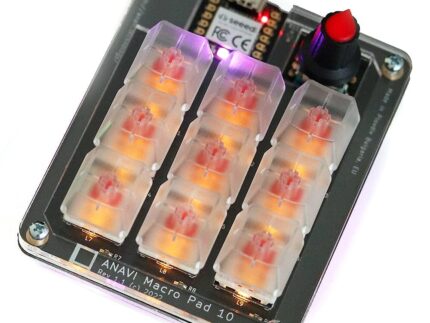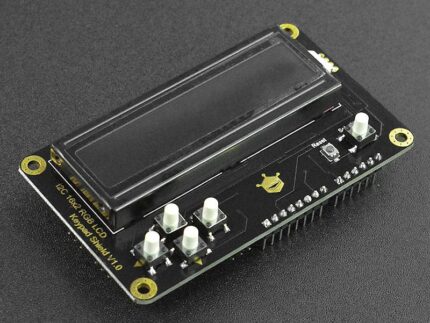Air Quality Control HAT for Raspberry Pi
Monitor, log, and react to gathered sensory data with the Kitronik Air Quality Control HAT for Raspberry Pi.
The Kitronik Air Quality Control HAT for Raspberry Pi provides a variety of sensor inputs and connection points for the Raspberry Pi and provides the ability to log, store and display data effectively with the Pi filesystem and an OLED screen. There are also connection points for external devices, such as analogue sensors, servos, motors, and heater pads that allow for additional monitoring and reading-based actions. This HAT is compatible with all Raspberry Pi versions that feature the 40-pin GPIO connector.
The board form factor complies with the Raspberry Pi standard for HATs, including the dual row of pin sockets to connect to the Pi. The HAT can then read inputs from a BME688 air quality and environmental sensor (temperature, pressure, humidity, air quality index and eCO2). The sensor, along with the RTC on the RP2040 IC and memory on the Pi means the board is well set up for data logging.
There is a black and white 128×64 OLED display screen and 3 status ZIP LEDs for visually displaying data, and a piezo buzzer for audio. There are also external connections: 2 1A outputs, a servo output, and 3 analogue input connections linking to the RP2040 ADC (some other GPIOs are broken out to 0.1” pitch solder pads as further inputs and outputs, along with pads for 3V and GND).
The Air Quality and Environmental HAT is powered via the Raspberry Pi GPIO connector – either 5V or 3.3V depending on the requirement for the section on the HAT. To connect the Air Quality Control HAT to a Pi: the interface connector should first be inserted into the HAT, and then the board should be pushed firmly onto the connector (the image on the left shows the HAT in place ready to be pushed down).
Kitronik has created a package for the Air Quality Control HAT which is hosted on PyPi. This means that the package can be installed very simply on the Pi with the following command:
pip install KitronikAirQualityControlHAT
The code, along with a README and example programs, can be found on the Kitronik GitHub repo.
Features
- Monitor, log, and react to gathered sensory data and then store and display data effectively with the Pi filesystem and an onboard OLED screen
- Add external devices, such as analogue sensors, servos, motors, and heater pads that allow for additional monitoring and reading-based actions
- Conforms to Raspberry Pi standard for HATs
- The HAT is powered via the Raspberry Pi GPIO connector
- High-Power Output: GPIO13 & GPIO19 (1A current draw max)
- Servo Output Control, GPIO6 (Supply Voltage) and Piezo Buzzer Control, GPIO26
- Analogue Inputs (RP2040 ADC): ADC0, ADC1 & ADC2 (Each with 3.3V & GND)
- ZIP LEDs: 3 onboard (controlled via RP2040)
- Additional Pin Breakouts: GPIO22, GPIO23, GPIO24 + 3.3V & GND
- BME688 & OLED Display Control: I2C Bus (GPIO2 & GPIO3)
- README information and example programs are available on the Kitronik GitHub repo
- This HAT is compatible with all Raspberry Pi versions that feature the 40-pin GPIO connector
- Dimensions:
- Length: 65mm
- Width: 56.5mm
- Height: 10.2mm
- PCB Thickness: 1.6mm
Resources
- Datasheet
- Library & Example code – GitHub
- Making an Outdoor Enclosure for Air Quality Control HAT
- Tech Talk Livestream playback
Package Contents
- 1x Kitronik Air Quality Control HAT for Raspberry Pi
Raspberry Pi not included










